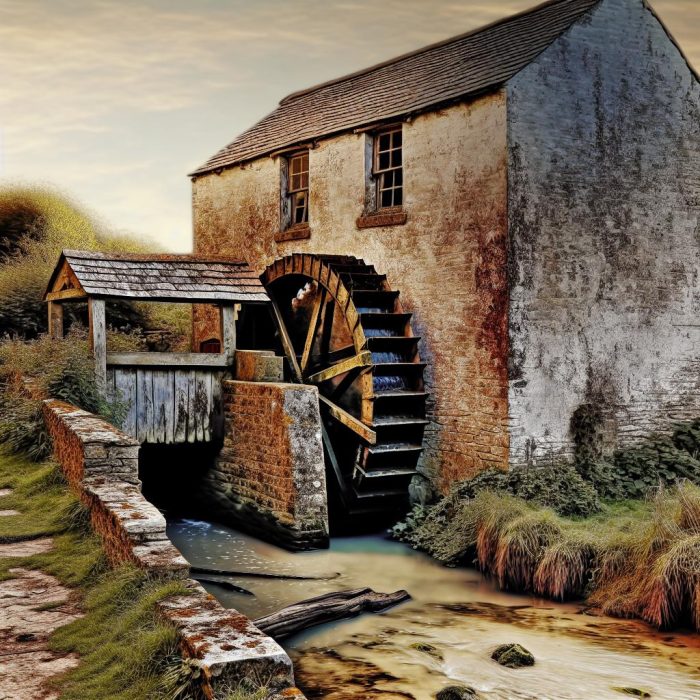The Emergence and Evolution of Watermills
Watermills have historically played a crucial role in advancing human civilization by acting as powerful mechanisms of mechanization. Predating the industrial era, they revolutionized various agricultural practices and significantly contributed to technological progress. Through the centuries, the utility and adaptation of watermills helped societies achieve greater productivity and opened the door to future innovations.
Early Beginnings
The idea of harnessing water to perform mechanical work can be traced back to ancient times. The earliest confirmed utilization of a water-powered mechanism emerged during the Hellenistic period, around the 3rd century BCE. These early watermills were primarily designed for grinding grain—a task that, before their invention, was labor-intensive and consumed a considerable amount of time when carried out manually. The introduction of watermills significantly alleviated this burden, enabling a substantial increase in productivity by leveraging the energy of flowing water.
The Role of Roman Innovation
The Romans are often recognized for elevating the design and application of watermills during their empire’s reign. Watermills became more commonplace across different regions as the Romans sought to exploit their benefits. A notable example of Roman innovation in watermills is the Barbegal mills located in southern France, dating back to the 4th century AD. These mills demonstrated sophisticated engineering by employing a series of interconnected mills to maximize the efficacy of the milling process. Such structures embodied the Roman commitment to engineering excellence and their ability to adapt engineering techniques to serve practical needs.
Medieval Expansion
As Europe transitioned into the Middle Ages, watermills witnessed an exponential increase in their number and usage. By the time of the Domesday Book, compiled in 1086, it was recorded that England alone boasted over 5,000 mills. The proliferation of watermills during this era was pivotal for enhancing agricultural productivity. They facilitated essential processes such as grain milling, fulling cloth, and sawing wood, which previously demanded substantial manual labor and resources.
Technological Advancements
This period saw significant advancements in watermill technology. Innovations like the breastshot wheel were introduced, allowing mills to operate effectively even under less-than-ideal water conditions. This innovation expanded the applicability of watermills, making them more versatile. Meanwhile, other developments, such as the post-mill, included the ability to rotate the entire mill structure in accordance with wind direction. Though primarily associated with windmills, this design innovation showcased the evolving thought processes in mechanical ingenuity parallel to watermills.
Global Influence
Watermills were not limited to Europe or the Mediterranean in their influence and adoption. In the Islamic world, watermill technology was adapted to fit regional requirements and technological contexts. In Persia, for instance, wind power integration with watermills became a significant development. In Asia, water-powered systems were incorporated into rice mills, highlighting a broader, cross-cultural exchange and adaptation encompassing diverse technological landscapes. The dissemination and adaptation of watermill technology underscore its immense global impact, underscoring its role in numerous cultural contexts.
The Industrial Transition
As the Industrial Revolution dawned, the conventional role of watermills began to shift. Technological breakthroughs such as steam engines—and later, electrification—supplanted water as the principal power source in manufacturing settings. Nevertheless, the foundational work carried out by watermills during earlier centuries laid the groundwork for these later mechanical innovations. Today, certain traditional watermills are preserved as cultural heritage sites. These preserved sites offer valuable insight into the technological advances of early human societies and stand as a tribute to humanity’s innovative spirit.
Conclusion
From their nascent utilization in ancient societies to their influential presence in medieval economies, watermills mark a pivotal chapter in the history of technological innovation. Their long-lasting legacy reflects the ingenious methods humans have employed to harness and adapt natural resources for societal advancement.
For those interested in delving deeper into how these ancient devices functioned and how they were integrated into everyday life, a visit to heritage sites featuring restored watermills may offer meaningful insights. Additionally, exploring scholarly publications dedicated to the study of ancient technologies can further enrich understanding. As such, watermills continue to captivate both historians and technology enthusiasts, enduring as symbols of human ingenuity and adaptability.



